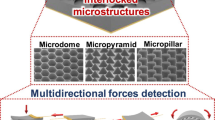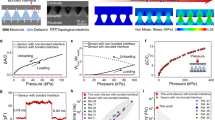Abstract
The development of wearable electronic skins is drawing many interests due to potential applications in prosthetic limbs, robotic skins, and human healthcare monitoring devices. Here, we demonstrate piezoresistive wearable electronic skins based on conductive composite elastomers with interlocked geometry of micropillar arrays. The interlocked micropillar arrays enable the huge variation of contact area and thus the contact resistance between interlocked micropillar arrays when they are deformed in response to external pressure stimuli. In this study, we show that the contact resistance is strongly affected by the variation of diameter, pitch size, and shape of micropillar arrays. The pressure sensor with optimized micropillar dimension shows an ultrahigh pressure sensitivity (−22.8 kPa−1) and response time (∼0.07 s). Finally, we demonstrate that the wearable electronic skin attached on the fingertip is capable of detecting the pressure and vibration signal simultaneously.






Similar content being viewed by others
References
Sekitani, T., Yokota, T., Zschieschang, U., Klauk, H., Bauer, S., Takeuchi, K., et al. (2009). Organic nonvolatile memory transistors for flexible sensor arrays. Science, 326(5959), 1516–1519.
Takei, K., Takahashi, T., Ho, J. C., Ko, H., Gillies, A. G., Leu, P. W., et al. (2010). Nanowire active-matrix circuitry for low-voltage macroscale artificial skin. Nature Materials, 9(10), 821–826.
Yamada, T., Hayamizu, Y., Yamamoto, Y., Yomogida, Y., Izadi-Najafabadi, A., Futaba, D. N., et al. (2011). A stretchable carbon nanotube strain sensor for human-motion detection. Nature Nanotechnology, 6(5), 296–301.
Pang, C., Lee, G.-Y., T-i, K., Kim, S. M., Kim, H. N., Ahn, S.-H., et al. (2012). A flexible and highly sensitive strain-gauge sensor using reversible interlocking of nanofibres. Nature Materials, 11(9), 795–801.
Tee, B. C., Wang, C., Allen, R., Bao, Z. (2012). An electrically and mechanically self-healing composite with pressure-and flexion-sensitive properties for electronic skin applications. Nature Nanotechnology, 7(12), 825–832.
Webb, R. C., Bonifas, A. P., Behnaz, A., Zhang, Y., Yu, K. J., Cheng, H., et al. (2013). Ultrathin conformal devices for precise and continuous thermal characterization of human skin. Nature Materials, 12, 938–944.
Wang, C., Hwang, D., Yu, Z., Takei, K., Park, J., Chen, T., et al. (2013). User-interactive electronic skin for instantaneous pressure visualization. Nature Materials, 12(10), 899–904.
Mannsfeld, S. C., Tee, B. C., Stoltenberg, R. M., Chen, C. V. H., Barman, S., Muir, B. V., et al. (2010). Highly sensitive flexible pressure sensors with microstructured rubber dielectric layers. Nature Materials, 9(10), 859–864.
Lipomi, D. J., Vosgueritchian, M., Tee, B. C., Hellstrom, S. L., Lee, J. A., Fox, C. H., et al. (2011). Skin-like pressure and strain sensors based on transparent elastic films of carbon nanotubes. Nature Nanotechnology, 6(12), 788–792.
Schwartz, G., Tee, B. C.-K., Mei, J., Appleton, A. L., Kim, D. H., Wang, H., et al. (2013). Flexible polymer transistors with high pressure sensitivity for application in electronic skin and health monitoring. Nature Communications, 4, 1859.
Persano, L., Dagdeviren, C., Su, Y., Zhang, Y., Girardo, S., Pisignano, D., et al. (2013). High performance piezoelectric devices based on aligned arrays of nanofibers of poly (vinylidenefluoride-co-trifluoroethylene). Nature Communications, 4, 1633.
Wu, W., Wen, X., Wang, Z. L. (2013). Taxel-addressable matrix of vertical-nanowire piezotronic transistors for active and adaptive tactile imaging. Science, 340(6135), 952–957.
Fan, F.-R., Lin, L., Zhu, G., Wu, W., Zhang, R., Wang, Z. L. (2012). Transparent triboelectric nanogenerators and self-powered pressure sensors based on micropatterned plastic films. Nano Letters, 12(6), 3109–3114.
Yao, H. B., Ge, J., Wang, C. F., Wang, X., Hu, W., Zheng, Z. J., et al. (2013). A flexible and highly pressure‐sensitive graphene–polyurethane sponge based on fractured microstructure design. Advanced Materials, 25(46), 6692–6698.
Ge, J., Yao, H. B., Wang, X., Ye, Y. D., Wang, J. L., Wu, Z. Y., et al. (2013). Stretchable conductors based on silver nanowires: improved performance through a binary network design. Angewandte Chemie, 125(6), 1698–1703.
Pan, L., Chortos, A., Yu, G., Wang, Y., Isaacson, S., Allen, R., et al. (2014). An ultra-sensitive resistive pressure sensor based on hollow-sphere microstructure induced elasticity in conducting polymer film. Nature Communications, 5, 3002.
Wu, Z. Y., Li, C., Liang, H. W., Chen, J. F., Yu, S. H. (2013). Ultralight, flexible, and fire‐resistant carbon nanofiber aerogels from bacterial cellulose. Angewandte Chemie International Edition, 52(10), 2925–2929.
Gong, S., Schwalb, W., Wang, Y., Chen, Y., Tang, Y., Si, J., et al. (2014). A wearable and highly sensitive pressure sensor with ultrathin gold nanowires. Nature Communications, 5, 3132.
Chen, Z., Ren, W., Gao, L., Liu, B., Pei, S., Cheng, H.-M. (2011). Three-dimensional flexible and conductive interconnected graphene networks grown by chemical vapour deposition. Nature Materials, 10(6), 424–428.
Park, J., Lee, Y., Hong, J., Ha, M., Jung, Y.-D., Lim, H., et al. (2014). Giant tunneling piezoresistance of composite elastomers with interlocked microdome arrays for ultrasensitive and multimodal electronic skins. ACS Nano, 8(5), 4689–4697.
Stassi, S., & Canavese, G. (2012). Spiky nanostructured metal particles as filler of polymeric composites showing tunable electrical conductivity. Journal of Polymer Science Part B: Polymer Physics, 50(14), 984–992.
Newns, D. M., Elmegreen, B. G., Liu, X. H., Martyna, G. J. (2012). High response piezoelectric and piezoresistive materials for fast, low voltage switching: simulation and theory of transduction physics at the nanometer‐scale. Advanced Materials, 24(27), 3672–3677.
Zhang, X.-S., Han, M.-D., Wang, R.-X., Zhu, F.-Y., Li, Z.-H., Wang, W., et al. (2013). Frequency-multiplication high-output triboelectric nanogenerator for sustainably powering biomedical microsystems. Nano Letters, 13(3), 1168–1172.
Acknowledgments
This work was supported by the National Research Foundation of Korea (NRF-2011-0014965, NRF-2012K1A3A1A20031618), BK21 Plus Program (10Z20130011057), Korea Institute of Machinery & Materials (KIMM) (NK175B), and Korea Institute of Science and Technology (KIST) (2E22112-11-249).
Author information
Authors and Affiliations
Corresponding author
Electronic supplementary material
Below is the link to the electronic supplementary material.
ESM 1
(DOCX 79 kb)
Rights and permissions
About this article
Cite this article
Park, J., Lee, Y., Lim, S. et al. Ultrasensitive Piezoresistive Pressure Sensors Based on Interlocked Micropillar Arrays. BioNanoSci. 4, 349–355 (2014). https://doi.org/10.1007/s12668-014-0151-8
Published:
Issue Date:
DOI: https://doi.org/10.1007/s12668-014-0151-8




